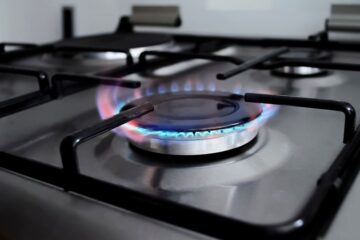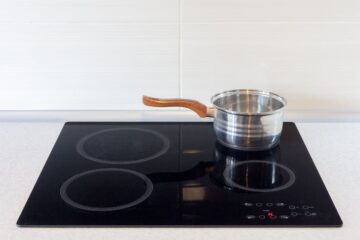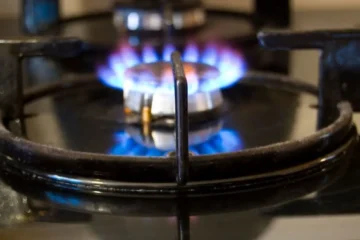Low heat on a stove can be a mystery for many home cooks. It’s often associated with slow cooking and simmering, but what exactly does low heat mean on your stovetop? There are a lot of myths surrounding this cooking method that can lead to frustration, burnt food, and wasted ingredients.
So, what is low heat? This blog post will dive into the myths and reality of low-heat cooking and help you understand how to master this essential cooking technique for your kitchen. This guide will provide tips and tricks to make you a confident cook, regardless of your experience level.
What Is Low Heat On A Stove?
Low heat on a stove refers to a cooking setting that uses a lower temperature than other heat settings, such as medium or high. It is used for simmering, melting, gentle heating, and keeping food warm without overcooking or burning it.
Low heat is achieved by turning the knob on the stove to a lower setting, reducing the heat generated by the heating element or burner. In electric stoves, this may mean adjusting the temperature control. In contrast, it may involve adjusting the flame size in gas stoves.
Low heat is important for delicate tasks such as simmering sauces, melting chocolate, or cooking delicate foods like fish or vegetables. Using a lower heat, you can cook these foods more slowly and gently, helping preserve their texture and flavor and avoid burning or overcooking.
Why Should You Consider Using A Low Heat On Your Stove?
There are several reasons why you should consider using low heat on your stove:
Gentle Cooking
Low heat allows you to cook delicate foods such as sauces, soups, and vegetables gently, preserving their texture and flavor.
Avoid Overcooking or Burning
Using low heat can avoid overcooking or burning delicate foods, which can ruin the dish and waste ingredients.
Simmering and Melting
Low heat is ideal for simmering sauces, soups, and stews and for melting chocolate, butter, or cheese.
Better Control
With low heat, you have more control over the cooking process, allowing you to cook slowly and adjust the temperature as needed.
Energy Efficiency
Using low heat can also be more energy efficient. It uses less energy than higher heat settings and takes longer to cook, reducing energy usage and costs.
How Is A Low Heat Different From A High Heat On A Stove?
Low and high heat are two cooking settings on a stove that produce different heat levels.
High heat is achieved by turning the stove knob to a high setting, which generates a lot of heat and is used for tasks such as boiling water, sautéing, and stir-frying. High heat is intense and is used for fast cooking.
On the other hand, low heat is achieved by turning the stove knob to a low setting, which generates less heat and is used for tasks such as simmering, melting, and gentle heating. Low heat is gentler and is used for slow cooking.
The key difference between low and high heat is the amount of heat generated. High heat generates a lot of heat, while low heat generates less heat, making it ideal for delicate tasks such as simmering or melting. You can avoid overcooking or burning delicate foods using low heat, while high heat is ideal for fast cooking tasks.
What Are The Safety Implications Of Having A Low Heat On A Stove?
While low heat can be a useful cooking setting, there are some safety implications to consider:
Fire Hazard
Low heat for extended periods can pose a fire hazard if food or grease accumulates on the stove and ignites. Always keep the stove and surrounding area clean and free of grease.
Scalding Hazard
Foods cooked on low heat can take longer, increasing the risk of scalding, especially if the pot or pan has a thin base or the heat source is uneven. Use cookware with thicker bases to help distribute heat evenly.
Leaving Food Unattended
Leaving food unattended on the stove, especially on low heat, can increase the risk of foodborne illness or contamination. Always monitor food while cooking, especially on low heat.
Overheating
Using low heat for extended periods can cause the stove to overheat, damaging the stove and increasing the risk of fire.
To minimize these safety risks, always follow the manufacturer’s instructions for using your stove, monitor food while cooking, and keep the stove and surrounding area clean and free of grease. If in doubt, consult a professional for advice.
The Dangers Of Low Heat On A Stove.
Low heat on a stove can pose several dangers, including:
Undercooking food
When food is cooked at low heat, it takes longer to reach safe internal temperatures, increasing the risk of foodborne illness.
Boiling over
Low heat can cause liquids to boil over, creating a fire hazard and making a mess on the stove.
Scorching
Low heat can cause food to stick to the bottom of the pan and scorch, producing smoke and fumes that can be harmful if inhaled.
Warping
Using low heat on some cookware can cause it to warp over time, making it difficult to cook evenly and increasing the risk of food burning.
How To Turn Up The Heat On A Stove?
To turn up the heat on a stove, you can follow these steps:
Locate the heat control knob or dial
The knob or dial is typically located on the front or side of the stove and controls the heat output of the burners.
Adjust the knob or dial
To turn up the heat, rotate the knob or dial in a clockwise direction. This will increase the heat output of the burner.
Check the temperature
After adjusting the heat, wait a few minutes for the burner to reach the desired temperature. You can use a thermometer or your hand to test the heat level.
How To Know When The Stove Is On Too Hot?
Here are some signs that your stove may be too hot:
Flames
If the flames from the burners are taller than the sides of the pan, the stove is likely too hot.
Smoke
If food starts to smoke or burn before it has finished cooking, the stove is probably too hot.
Scorching
If the bottom of the pan is black or discolored, this could be a sign that the heat is too high and the food is scorching.
Boiling over
If liquids in the pan are boiling over and creating a mess, this may indicate that the heat is too high.
Tips For Avoiding Stove Accidents.
Keep the stove and surrounding area clear
Make sure that there are no flammable items near the stove and that the area around the stove is free of clutter.
Use proper cookware
Use cookware appropriate for the type of stove you have and for your cooking. Avoid using cookware that is damaged or warped.
Use pot holders
Always use pot holders or oven mitts when handling hot cookware to protect your hands from burns.
Keep a fire extinguisher nearby
Keep a fire extinguisher in the kitchen and ensure that everyone in the household knows how to use it.
Keep the stove and burners clean
Regularly clean the stove and burners to remove any grease or food particles that could ignite.
Be attentive while cooking
Don’t leave the stove unattended, and avoid cooking while distracted.
What Is Medium Low Heat On A Gas Stove?
Medium-low heat on a gas stove is a setting that provides a moderate to low level of heat output. This setting is typically used for slower cooking techniques, such as simmering or braising, where you want to maintain a gentle heat to avoid boiling or burning the food.
The exact temperature corresponding to medium-low heat can vary depending on the stove, but it is generally between 200°F and 300°F. To achieve medium-low heat, you may need to adjust the heat control knob to a position between the low and medium settings. You can also use a thermometer or your hand to gauge the heat level and make further adjustments.
Should I Keep My Heating On Low All Day?
Whether you should keep your heating low all day depends on various factors, such as your personal preferences, the weather outside, and your heating system. Here are some things to consider:
Energy efficiency
Keeping the heating low all day can increase your energy bill, as your heating system must constantly work to maintain a low temperature.
Comfort
If you are at home all day, keep the heating at a comfortable temperature to avoid feeling cold.
Thermostat settings
If you have a programmable thermostat, you can set it to automatically turn off the heating when you are away and turn it back on when you return, which helps save energy.
Insulation
The level of insulation in your home can also impact your heating needs. If your home is well-insulated, you can keep the heating off for longer.
What Is Low Heat On Induction Stoves?
Low heat on an induction stove is a cooking setting that provides a gentle heat output. This setting is typically used for slow cooking techniques, such as simmering or melting, where you want to maintain a low temperature to avoid boiling or burning the food.
The exact temperature corresponding to low heat on an induction stove can vary depending on the stove, but it is generally between 125°F-150°F.
What Is Low Heat On Electric Stove?
“Low heat” on an electric stove refers to a cooking temperature lower than medium heat. It is used for simmering, warming, or slow-cooking food and is characterized by a lower heat energy output from the stove’s heating elements. The temperature for low heat can vary based on the stove, but it is typically between 200°F to 250°F.
The Final Words
As you can see, what is low heat on a stove ultimately depends on how you define low heat. From that angle, there is no single answer here—only an understanding that not all stoves are equal. The amount of time and the setting required to acclimatize food can vary from one range to another. Hopefully, this post has helped shine some light on this topic.
Frequently Asked Questions
What Temperature Is Low Heat On A Stove?
Low heat on a stove is typically around 200-250°F. It’s a low, slow heat ideal for simmering and cooking delicate foods.
What Is Considered Low Heat Cooking?
Low-heat cooking is defined as cooking with temperatures below 300 degrees Fahrenheit. This cooking method involves slow and gentle heat, allowing food to cook evenly and retain its natural flavors and juices.
What Number Is Low Heat On An Oven?
Low heat in an oven is typically between 120°C and 150°C. This temperature range is used for slow cooking and keeping food warm.
What Is Low On The Stove Number?
Low on the stove refers to the temperature setting on a stove burner where the heat is low or minimal. It is typically represented by the number 1 or 2 on most stove dials.
What Temperature Is 7 On A Stove?
7 on a stove typically represents medium heat, around 375-400°F. It is a commonly used temperature for basic cooking and simmering.
Is Simmer Low Or 2?
Simmer refers to a cooking technique where food is cooked at a low heat just below boiling point. It is not a numerical value but rather a level of heat.



